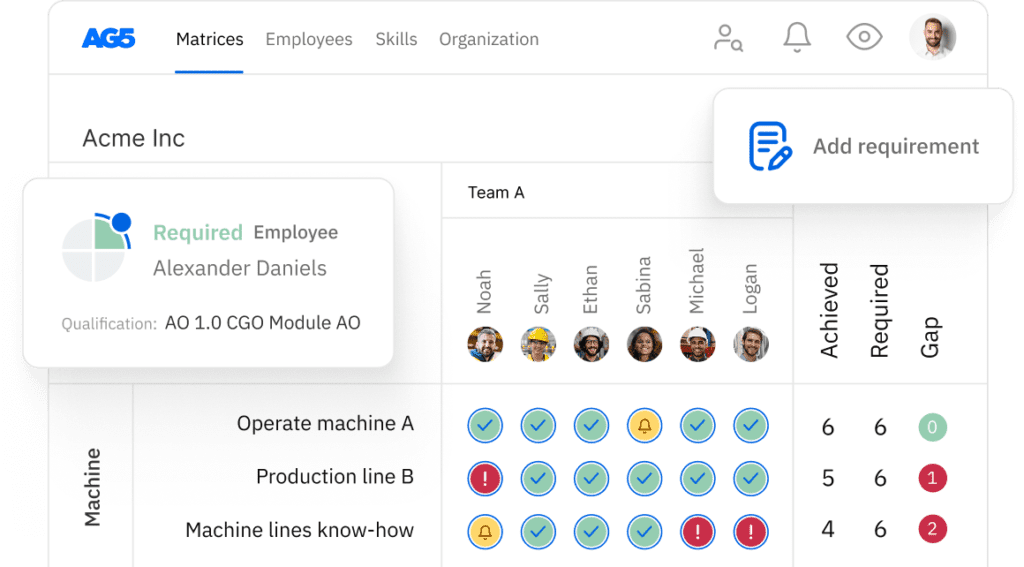5 key differences: Discrete manufacturing vs. process manufacturing
We’ll take a look at both discrete and process manufacturing and highlighting their key differences, as well as how skills management can be utilised in both.

Manufacturing organizations must consider myriad factors when it comes to managing the skills of their employees. From ensuring that production processes stay operational, to improving overall workplace safety, there are a great many moving pieces.
This becomes even more complicated when taking into account different types of manufacturing, such as discrete manufacturing and process manufacturing. These methods are used for different purposes, and as such require different approaches to skills management, with employees requiring skills, qualifications, and certifications in varying areas.
In this article, we’ll take a look at both discrete and process manufacturing, first highlighting their key differences before moving on to show how AG5 is an effective skills management solution for both.
What is discrete manufacturing?Copied
Discrete manufacturing refers to the production of distinct items that can be easily counted, touched, or seen as separate entities. [1] It involves the assembly of individual components to create a finished product.
Discrete manufacturing is commonly used in industries such as automotive, aerospace, electronics, and consumer goods. Some key features of discrete manufacturing include:
- Bill of Materials (BOM). Discrete manufacturing relies heavily on a bill of materials, which outlines the list of components and quantities needed to assemble the final product.
- Assembly line production. Discrete manufacturing often involves the use of assembly lines, where individual parts are assembled step by step to create the final product.
- Product traceability. There is a clear traceability of components and parts used in the manufacturing process, allowing for easy identification of any faulty parts or components.
- Customization. Discrete manufacturing allows for more customization and variation in the final products, enabling manufacturers to cater to specific customer demands.
- Quality control at each stage. Quality control is implemented at various stages of the assembly process to ensure that the final product meets the required standards.
What is process manufacturing?Copied
Process manufacturing involves the production of goods that cannot be easily broken down into individual units, as they are typically produced in bulk quantities using formulas or recipes. [2]
Process manufacturing is commonly used in the food and beverage, chemical pharmaceutical, and oil and gas industries. The notable characteristics of process manufacturing include:
- Formula or recipe-based production. It relies on specific formulas or recipes to produce goods, where precise measurements and mixing processes are crucial.
- Continuous production. The production process is often continuous, with a constant flow of materials through various stages such as mixing, blending, and chemical reactions.
- Bulk production. Goods are produced in large quantities, often requiring specialized storage and handling facilities.
- Regulatory compliance. Process manufacturing is subject to stringent regulatory requirements, especially in industries such as pharmaceuticals and food, where adherence to quality and safety standards is crucial.
- Advanced process control systems. Manufacturers often employ advanced process control systems to monitor and regulate the production process, ensuring consistency and quality in the final products.
5 key differences between discrete manufacturing and process manufacturingCopied
Based on their descriptions, it is already clear that discrete and process manufacturing are quite different. In this section, we’ll take a deep dive into them, highlighting five key ways the two processes diverge.
1. Production methodology
In discrete manufacturing, the production process involves the assembly of distinct components to create a finished product. [3] Each unit is separately identifiable. Examples include:
- Automobiles
- Smartphones
- Furniture
Process manufacturing involves the use of formulas or recipes to produce goods that cannot be broken down into individual units. The products are typically produced in bulk quantities, and the process is continuous. Examples include:
- Chemicals
- Food and beverages
- Pharmaceuticals
2. Inventory management
Inventory management [4] in discrete manufacturing revolves around the management of:
- Parts
- Components
- Assemblies
Manufacturers need to maintain an inventory of various components and assemble them according to specific orders.
On the other hand, process manufacturing requires managing large quantities of:
- Raw materials
- Work-in-progress products
- Finished goods
In process manufacturing, the focus is on managing the continuous flow of materials throughout the production process.
3. Production flexibility
Because manufacturers can adjust production lines to accommodate changes in product design or customer demand:
- Discrete manufacturing allows for more flexibility in production processes [5]
Alternatively, because its production processes are often designed for specific products, and changing the production setup can be complex and time-consuming:
- Process manufacturing is less flexible
4. Quality control
Quality control [6] in discrete manufacturing is often focused on:
- Individual components and the assembly process
Manufacturers can implement quality checks at different stages of the assembly to ensure the final product meets the required specifications.
In process manufacturing, quality control is more focused on:
- Maintaining consistency in the production process
Manufacturers need to ensure that the raw materials and the production conditions remain consistent to produce goods with the desired quality.
5. Equipment and technology
Discrete manufacturing often requires specialized equipment [7] for:
- Assembling
- Machining
- Fabricating individual components
Manufacturers may use technologies like robotics and computer-aided design (CAD) software for precision and automation.
Process manufacturing relies on specialized machinery and equipment designed for continuous production. It often relies on technologies such as:
- Process control systems
- Robotics
- Automation
By doing so, manufacturers are more easily able to continuously monitor and regulate the production process.
How skills management can bridge the gap between discrete manufacturing and process manufacturingCopied
The key distinction between discrete and process manufacturing lies in the nature of production, with discrete manufacturing involving the assembly of distinct items, and process manufacturing dealing with the production of goods through a continuous process.
This will affect an organization’s skills management strategy by requiring different areas of focus depending on the manufacturing process used.
For example, in discrete manufacturing, organizations will find that it is more important to properly manage the skills of employees in areas such as:
- Assembly line operations
- Quality control
- Precision engineering
In contrast, process manufacturing necessitates increased expertise in:
- Process optimization
- Quality assurance
- Understanding of chemical reactions or material transformations
Of course, there will always be some overlap – every manufacturing organization needs employees trained in quality control and process optimization, for instance – but a skills management strategy tailored to either discrete or process manufacturing will exhibit noticeable differences.
That’s where AG5 comes in.
Want to see how AG5 can streamline skills management for discrete manufacturing and process manufacturing?Copied
Whether your organization leverages discrete manufacturing or process manufacturing, AG5 is ready to help.
By implementing AG5’s skills management software, you will leverage a centralized hub of all the information related to skills, qualifications, and certifications your employees will need for both discrete manufacturing and process manufacturing.
Ready to see AG5 in action? Book a free, live, 15-minute demo today to see how AG5 can change the way your organization approaches manufacturing.
Sources Copied
- Change view: Table
-
APA
| # | Source title | Description | Publication | Retrieved | Source URL |
|---|---|---|---|---|---|
| 1 | What is discrete manufacturing? | TechTarget | - | March 27, 2024 | https://www.techtarget.com/sea.. |
| 2 | What is process manufacturing? | TechTarget | - | April 17, 2024 | https://www.techtarget.com/sea.. |
| 3 | Discrete vs. Process Manufacturing – How Do They Differ? | MRPeasy | - | April 18, 2024 | https://manufacturing-software.. |
| 4 | Supply Chain Management in Process vs. Discrete Manufacturing: Key Differences You Need to Know. | Medium | - | April 17, 2024 | https://medium.com/omneelabWMS.. |
| 5 | Process Manufacturing vs Discrete Manufacturing. | Confianz | - | April 18, 2024 | https://www.confianzit.com/cit.. |
| 6 | Discrete Manufacturing: An Overview Of Features, Functionalities, And Uses. | Inecta | - | April 18, 2024 | https://www.inecta.com/blog/di.. |
| 7 | Process Manufacturing vs Discrete Manufacturing: Definitions and Differences. | Inbound Logistics | - | April 17, 2024 | https://www.inboundlogistics.c.. |
Author Copied
Revisions Copied
Written by: Rick van Echtelt
Copy edited by: Adam Kohut

